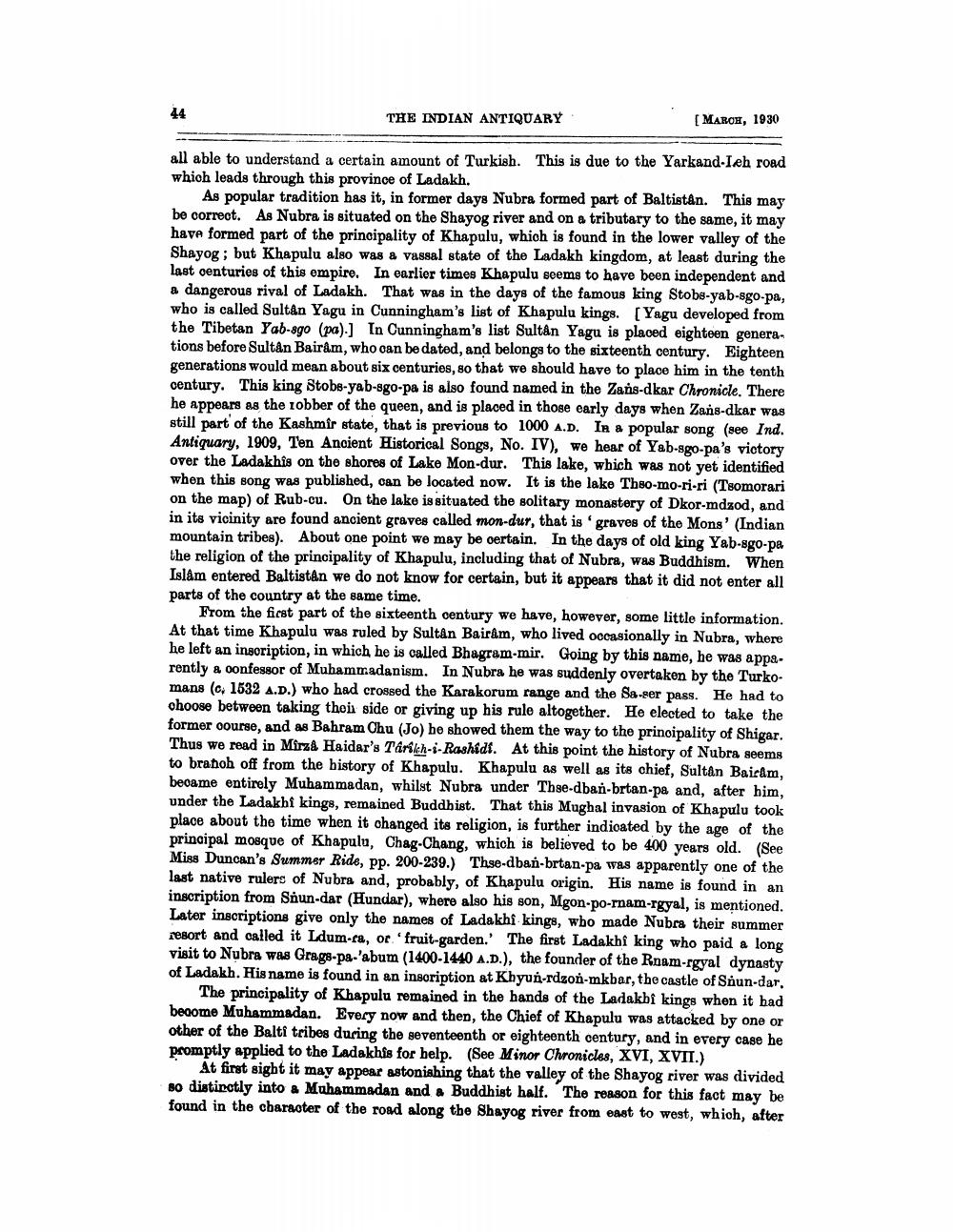________________
THE INDIAN ANTIQUARY
[MAROH, 1930
all able to understand a certain amount of Turkish. This is due to the Yarkand-Ieh road which leads through this province of Ladakh.
As popular tradition has it, in former daya Nubra formed part of Baltistan. This may be correct. As Nubra is situated on the Shayog river and on a tributary to the same, it may have formed part of the principality of Khapulu, which is found in the lower valley of the Shayog; but Khapulu also was a vassal state of the Ladakh kingdom, at least during the last oenturies of this empire. In earlier times Khapulu seems to have been independent and a dangerous rival of Ladakh. That was in the days of the famous king Stobs-yab-sgo pa, who is called Sultan Yagu in Cunningham's list of Khapulu kings. (Yagu developed from the Tibetan Yab-sgo (pa).] In Cunningham's list Sultan Yagu is placed eighteen generations before Sultan Bairâm, who can be dated, and belongs to the sixteenth century. Eighteen generations would mean about six centuries, so that we should have to place him in the tenth century. This king Stobs-yab-ego-pa is also found named in the Zans-dkar Chronicle. There he appears as the robber of the queen, and is placed in those early days when Zans-dkar was still part of the Kashmir state, that is previous to 1000 A.D. In & popular song (see Ind. Antiquary, 1909, Ten Ancient Historical Songs, No. IV), we hear of Yab-sgo-pa's victory over the Ladakhis on the shores of Lake Mon-dur. This lake, which was not yet identified when this song was published, can be located now. It is the lake Thso-mo-ri-ri (Tsomorari on the map of Rub-cu. On the lake is situated the solitary monastery of Dkor-mdzod, and in its vicinity are found ancient graves called mon-dur, that is graves of the Mons' (Indian mountain tribes). About one point we may be certain. In the days of old king Yab-sgo-pa the religion of the principality of Khapulu, including that of Nubra, was Buddhism. When Islam entered Baltistan we do not know for certain, but it appears that it did not enter all parts of the country at the same time.
From the first part of the sixteenth century we have, however, some little information. At that time Khapulu was ruled by Sultan Bairam, who lived occasionally in Nubra, where he left an insoription, in which he is called Bhagram-mir. Going by this name, he was apparently a confessor of Muhammadanism. In Nubra he was suddenly overtaken by the Turkomans (c. 1532 A.D.) who had crossed the Karakorum range and the Sa-ser pass. He had to choose between taking their side or giving up his rule altogether. He elected to take the former course, and as Bahram Chu (Jo) he showed them the way to the prinoipality of Shigar. Thus we read in Mirza Haidar's Tarikh-i-Rashidi. At this point the history of Nubra seems to branoh off from the history of Khapulu. Khapulu as well as its chief, Sultan Baicam, became entirely Muhammadan, whilst Nubra under Thse-dban-brtan-pa and, after him, under the Ladakhi kings, remained Buddhist. That this Mughal invasion of Khapulu took place about the time when it changed its religion, is further indioated by the age of the principal mosque of Khapulu, Chag-Chang, which is believed to be 400 years old. (See Miss Duncan's Summer Ride, pp. 200-239.) Thee-dban-brtan-pa was apparently one of the last native rulers of Nubra and, probably, of Khapulu origin. His name is found in an inscription from Snun-dar (Hundar), where also his son, Mgon-po-rnam-rgyal, is mentioned. Later inscriptions give only the names of Ladakhi kings, wbo made Nubra their summer resort and called it Ldum.ca, or fruit-garden.' The first Ladakhí king who paid a long visit to Nubra was Grags-pa-'abum (1400-1440 A.D.), the founder of the Rnam-rgyal dynasty of Ladakh. His name is found in an insoription at Khyun-rdzon-mkbar, the castle of Saun-dar.
The principality of Khapulu remained in the hands of the Ladakhi kings when it had become Muhammadan. Every now and then, the Chief of Khapulu was attacked by one or other of the Balti tribes during the seventeenth or eighteenth century, and in every case he promptly applied to the Ladakhis for help. (See Minor Chronicles, XVI, XVII.)
At first sight it may appear astonishing that the valley of the Shayog river was divided 80 distinctly into a Muhammadan and a Buddhist half. The reason for this fact may be found in the character of the road along the Shayog river from east to west, which, after




